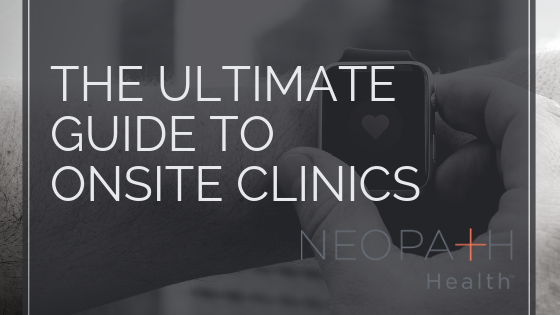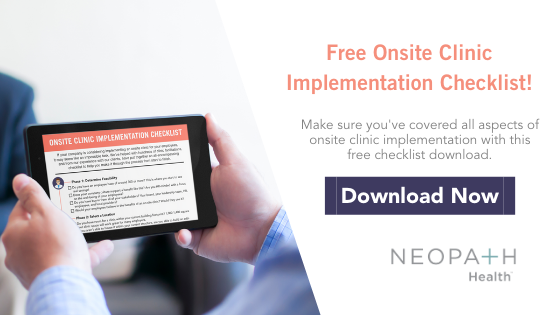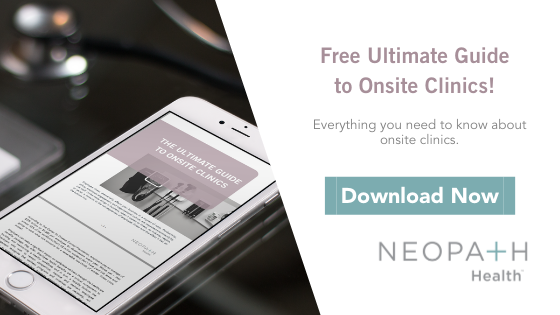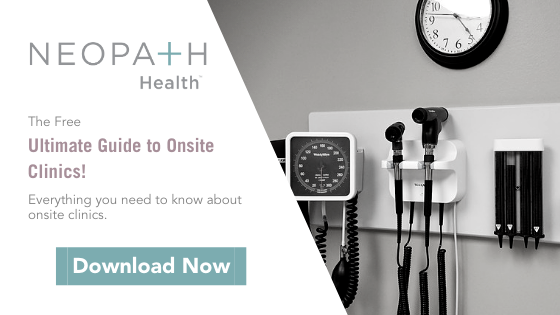Employee illness dramatically affects your business in a myriad of ways. Productivity, safety, employee engagement, and organizational culture, are impacted enormously by sick staff. Unlike many things in business, when it comes to illness, no industry, region, or sector is immune to the consequences of employee illness and the effect it has on the bottom line.

According to The Center for Disease Control Foundation, employers pay an average of $225 billion or $1,685 per employee for absenteeism every year. Worse yet – that almost 40% of the workforce (that’s 48 million workers) don’t have paid sick leave and going to work while sick accounts for a remarkable two-thirds of worker illness costs overall.
Employers can make a significant impact on workplace wellness through the healthcare benefits package they offer. Employee health benefits are a critical component to building and maintaining a healthy workforce and in turn, a healthy bottom line. Employers who wish to remain competitive, improve and maintain employee engagement recognize that wellness programs and initiatives are necessary, not optional. In today’s modern workplace however, employers have options that go beyond a standard healthcare plan, one of those options being, an onsite clinic.
In the Ultimate Guide to Onsite Clinics you’ll learn:
-
The Difference Between Traditional Heatlhcare and Onsite Clinics
-
The Role of Onsite Clinics in a Modern Benefits Package
-
Benefits of an Onsite Clinic
-
How to Select an Onsite Clinic Vendor
-
How to Implement an Onsite Clinic
In any given year, how much time do employees spend going to the doctor? Think about not just the time in the exam room, but the time it takes to travel to the appointment, time spent in the waiting room, picking up prescriptions, etc. Time aside, that doesn’t factor in the actual cost of the doctor’s visit and the premiums both the company and the employee pay to have a traditional, corporate healthcare plan.
You’ve likely heard about onsite clinics, but might be asking yourself, “How are they different from the traditional healthcare plan model we currently use?” According to the National Association of Worksite Health Centers, a workplace “onsite clinic” is a setting where an employer offers one or more medical and wellness services, delivered by licensed providers, to all or a portion of eligible employees and their family members.
Onsite clinics have grown in popularity over the last fifteen years. According to Springbuk, what used to be just basic occupational health and safety services offered, has expanded. A few of the services they sited that onsite clinics provide today include:
-
Wellness Initiatives- Weight loss initiatives, health risk assessments and health education.
-
Preventative Care– Health screenings, flu shots, annual physical checkups.
-
Acute Care– Short-term treatment of illnesses such as colds, the flu, minor infections, or minor sprains and cuts.
-
Condition and Disease Management- Ongoing treatment of chronic health conditions, such as diabetes or heart disease.
-
Specialty Care- Orthopedics, dietetics, physical therapy, and pharmacy.
The best part, onsite clinics are located at your company. That means no drive time or waiting in crowded waiting rooms and unlike with a corporate healthcare plan, employees don’t have to worry about trying to determine if the physician they’re seeing is in-network or out-of-network before seeking care.
A 2015 study by The InHouse Physicians found that patients can save up to 2 to 4 hours per visit using onsite clinics than those who have to travel off site.
Onsite clinics aren’t a “one size fits all” model though. Each site’s services, staffing, and costs should be customized to meet the needs of your particular organization. Flexibility you don’t often find with traditional healthcare plans.
Traditional healthcare tends to be more reactive.
People tend to utilize the services once there’s already a problem. The onsite clinic approach attempts to be more proactive and prevent illness by incorporating wellness programs and preventative care. With services available onsite and at a lower cost, employees are hopefully less likely to put off seeing a doctor and can avoid a minor issue becoming a more serious one.
All of this considered, while there’s a number of differences between onsite clinics and corporate healthcare plans, the real difference comes down to convenience, cost savings, and overall improved health for your company and its employees.
There are several benefits to offering an onsite clinic as part of your employee benefits package and they aren’t limited to employees only, employers reap the benefits as well.
Onsite Clinics are Convenient for Employees
Employees are more likely to seek preventive services, get treatment for illnesses, and keep up with prescriptions if it’s convenient. Plain and simple. Ease of access is huge. Patients are able to take care of their health and as a bonus, they don’t need to take significant time away from work to do so. The more intune employees are with their health, the less likely they will have need for hospital visits, surgeries or have conditions that go undiagnosed and untreated. Sick employees obviously miss more days of work than healthy ones.
Onsite Clinics Allow for Increased Employee Productivity
When employees have to leave campus for appointments, they’re often gone for a half day or more due to the commute, wait times, and follow up. Not to mention if they have lab tests or prescriptions to pick-up. Onsite clinics limit this time, often allowing employees to get the treatment they need while missing an hour or less of work. And again, we have to mention that healthy employees are more productive and produce better quality work than their unhealthy counterpart.
Onsite Clinics Reduce ER Visits for Employees
When employees can get first aid and treatment of minor illness like ear infections and influenza on site, they’re less likely to seek treatment in the emergency department, which reduces costs for both the employee and the employer.
Onsite Clinics Prioritize Preventative Care
When a company has medical professionals in close proximity (often cases right down the hallway), health is often top of mind and ingrained in the company culture. The overall interest in and awareness of health-related issues increases amongst the general employee population.
The clinic is able to fuel the health-related conversation by doing marketing campaigns to increase awareness around specific common diseases and illness that are likely affecting your employees such as heart disease, diabetes, or breast cancer. They are also often able to run specific wellness programs and initiatives in-house that are tailored to your company and will increase the overall health of your staff.
Also, with employees frequenting the same physician for primary care needs, they can develop a rapport with their care provider. This promotes conversation and often helps patients uncover a comprehensive health profile to manage care. This can lead to opportunities to educate patients about their conditions and create lifestyle changes to prevent future events, plus connect them to other necessary health resources if needed.
Onsite Clinics Help To Recruit and Retain Top Talent
There is no doubt about it that the landscape for recruiting and retaining top talent is fiercely competitive. Benefits are an important factor when it comes to candidates and current employees considering employment offers.
Onsite Clinics Reduce Employer Healthcare Cost
Overall costs are reduced in on-site clinics because the benefits are realized in ways other than direct profit, which keeps costs low.
Onsite clinics reduce costs that lead to a healthier bottom line through the following:
-
High Claim Mitigation: Repeated clinic use can identify prevalent chronic disease and the opportunity for preventative care, reducing large, complex claims. It also leads to less emergency room visits for non-emergency conditions which are huge expenditures for organizations.
-
Trend Management: Early identification of potential future large claims and appropriate health management can lower the medical trend experienced by the health plan.
-
Concierge Services: Should a diagnosis require advanced levels of care, the onsite medical team expertise can assist in the search for a specialist, along with facilitating the transition. The medical team will be acutely aware of the existing ‘in-network’ specialists, keeping both the organization and member expense in mind.

Is your organization considering implementing an onsite clinic, but not quite sure what questions to ask when selecting a vendor? Onsite clinic vendors are not one size fits all and being informed is critical to success when it comes to selecting a partner and making the right choice for your employees.
Here are six questions to ask prior to selecting a vendor to get you well on your way to achieving your company financial and health and wellness objectives.
#1: Who Will Be the Care Providers?
It’s important to understand who will be administering the care to your employees in your onsite clinic. You can compare it to the thought process you have when you make a hire internally. How critical is it that the person fits with your company culture?
The same can be said for when hiring onsite clinic staff. Onsite clinics can treat everything from a workplace injury, to a chronic disease and can ultimately have a huge impact on your organization and employee health. For that reason alone, it’s crucial that employers are involved in the recruiting of their onsite clinic staff. Your vendor should oversee the process and hire with your company's best interest in mind.
#2. What Services Will Be Covered by the Onsite Clinic?
Technically speaking, onsite clinics can provide a wide array of services, however, the decision of which services the clinic will offer, ultimately lies with the employer and the vendor. Will the clinic treat general health concerns? Or will the clinic only treat injuries that happen to employees on the job? This needs to be considered and answered early on in the planning phases.
Click here to have this Ultimate Guide to Onsite Clinics email to you.
#3. How Does the Vendor Plan to Encourage Employee Participation?
Having an onsite clinic that isn’t utilized, doesn’t benefit anyone. Don’t be concerned however if employees aren’t lining up to use the services right away. Sometimes employees need some pushing in the right direction to help them fully realize the benefits an onsite clinic has to offer them and in order to full take advantage of all of the benefits, successful clinic management hinges on engaging the right employees at a time that makes the most sense for them based off of their current health happenings.
The vendor you select should have access to real-time data from your employee pool to conduct outreach strategies that actually apply to your current workforce. Timely and pertinent outreach makes a huge difference and is the most likely to lead to action and long-term health.
#4. How Does the Vendor Plan to Measure ROI?
ROI is the name of the game and a must for any program. Onsite clinics are no exception. Numbers are significant because they highlight not only the successes of the clinic, but also the areas that need improvement.
The vendor you select needs to not only be able to capture meaningful data, but to also have a clear plan of action for reviewing and optimizing the program based on the numbers. The vendor should be focusing on:
-
Employee participation metrics
-
Employer cost savings
-
Employee cost savings
-
Quality of care
It’s important that KPI’s are determined and agreed upon collectively prior to the launch of the onsite clinic.
#5. How Secure is the Data?
Health related information is highly sensitive and extremely personal. The vendor should be able to provide detailed, audited proof that they have secured all privacy and security related processes and are in compliance with the latest security recommendations.
#6. Has the Vendor Had Past Success?
Customer success stories speak volumes. Does the vendor willinging share customer testimonial and case studies? If they do, that’s a great sign! However, it’s important the stories they share are rooted in data and backed by strong stats and figures. Remember, one of the main reasons to implement an onsite clinic is to save money. If a vendor can’t share a specific example where they decreased costs, proceed with caution. Will the clinic go a step further and share actual clinic performance data, not speculative projections extrapolated from average savings reported in the literature?

Do you feel like implementing an onsite clinic seems like an impossible task? If you do, you aren’t alone, but in actuality, with the right partner, it’s much easier than you might think. Each clinic implementation can vary, but there are key areas of focus that apply to companies across the board.
We compiled a list of eight critical steps to follow for implementing an onsite clinic below.
Determine Feasibility
Onsite clinics may not be the best option for every company. For example, companies who have an employee base over 300 can really start to see the cost savings at that scale. A clinic then becomes not just affordable but beneficial to the bottom line.
Often the largest component of the feasibility of an onsite clinic is not just the size of the population, it is the culture that exists within the organization. The entire spectrum of your organization needs to be aligned with the purpose of bringing care to the workplace, it doesn’t mean 100% of the workforce will be on board but multi-tier support is invaluable.
Not quite at the 300 employee mark? Did you know that you don’t have to go it alone? Sharing an onsite clinic with another company is an option! Consider partnering with another business in your area to create a shared clinic and reap the benefits together.
Select a Location
Throughout this guide, we have been discussing onsite clinics, but technically, near-site clinics can work too if you don’t have space within your current facility. Ideally, the space would have:
-
A minimum of 1,000 - 1,4000 square feet
-
Access to electricity
Determine Eligibility
Determining eligibility is a major consideration. Will your patient population be just employees or employees plus their dependents? Many decide to cover dependents too because up to ⅔ of benefits costs are in the dependent base. This is often a welcome benefit to employees!
Consider Opportunity Cost
As stated earlier, onsite clinics save your company money. When a business has employee scale and growing healthcare costs, a fully operational clinic can easily reach seven figure savings. Every month you wait to start an onsite clinic, transfers more of your resources to the traditional healthcare industry.
Marketing
An onsite clinic is a great benefit to your employees and their families, but only if they put it to good use. The sooner you can drive clinic engagement, the sooner you will see results across the board from the increased health of your employees, to the increased company savings. This is why effective and regular communication about the opportunity and convenience an onsite clinic provides is often the first step!
Pro tip: Hosting an event like an open house or a meet and greet with the clinic staff, is a great way to kick off the clinic and drive engagement!
Financing
How to finance a onsite clinic? This might seem hard to believe, but the dollars to fund an onsite clinic are likely already in your budget. You don’t need to find new funds to make this happen. More often than not, the dollars for establishing a clinic can come out of your health plan account, not your general fund.
When it’s time to get started, the onsite clinic vendor that you select should be willing and able to help with financial advice and best practice.
Design and Build
Designing and building an onsite clinic is not as difficult as you might think and actually, your in-house facilities team may be able to handle everything. If not, your onsite clinic vendor should be able to help you find a great contractor team.
Hiring the Medical Team
You don’t have to tackle the hiring of your medical team on your own. The onsite clinic vendor should work with you to select and build the proper team for your employee/dependent population. You should be able to look to them to hire talented, motivated, board-certified physicians and staff.

A good onsite clinic is modeled and staffed to meet the unique needs of your workforce and should grow alongside your company. At NeoPath Health, the approach to healthcare is based on the idea that there is no substitute for creating a relationship with the patient. A minute of care can’t treat a lifetime of problems. That’s why NeoPath’s proactive primary care clinics are fully staffed with physicians, nurses, pharmacists and other healthcare professionals. It allows us to dispense more than the temporary solutions that fail to address the underlying issues. Our staff creates genuine relationships with our patients and provides diagnosis, treatment, prevention and education all in one place.
It’s common for employers to shy away from onsite clinics because they worry about the complexity: governing bodies, rules and regulations, staff privileging and credentialing, liability, medical equipment, space that meets specifications – the list is extensive. We’re here to tell you that you’re not alone. We know how complex it is and that’s why we founded NeoPath Health over ten years ago. When you partner with us, getting started and keeping your clinic running smoothly is easy. To learn more about feasibility in your own organization or take the first steps toward implementing this win-win benefit for your staff, contact us today.
.png?width=433&name=NeoPath_2019_logo_2color%20(1).png)







